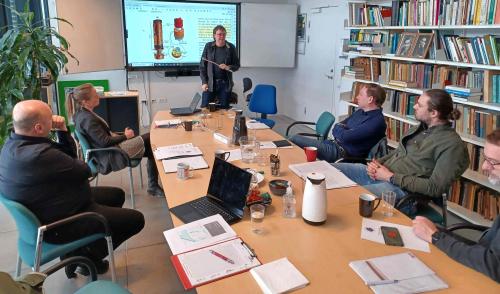Physicists from RUC in collaboration with major German company

The mobile phone in your pocket is held together by many layers of adhesive tape, and in the cars on the road, adhesive products also play a significant role in the assembly of various parts.
But what happens to the adhesive material's capacity to hold the mobile phone together if you drop it, causing it to receive a shock when it hits the floor?
That kind of thing can be incredibly difficult to measure, but researchers at the Department of Science and Environment at Roskilde University have developed a method that can do just that. Among the group of researchers are Professor Jeppe Dyre and Assistant Professor Tina Hecksher.
This has caught the interest of the large German company tesa SE. Tesa SE produces adhesive products for both consumers and industry, and recently the company and researchers at Roskilde University have had a scientific collaboration because the company wants to know more about the mechanical properties in their adhesive products for industrial use.
As part of the collaboration, a group from tesa SE and their partners have visited Roskilde University.
"It is a pleasure for tesa SE to collaborate with the Glass and Time group at Roskilde University. The group has developed a method for measuring mechanical properties that we intend to implement in our development laboratory. Our visit to Roskilde was to learn more about this method that is unique in the world," says Dr. Sebastian Schmidt-Lehr, group leader from the Corporate Test Method Lab at tesa SE.
Researchers want to share their knowledge
The researchers at Roskilde University have developed the measurement method, called the Piezoelectric Shear Gauge, to measure the mechanical properties in viscous liquids, but the method has proven effective with other materials as well.
The method enables researchers to measure a shear deformation, which is a very small displacement in the sample. The force required for this depends on how quickly the deformation is performed.
"Standard instruments can measure it up to a certain speed, but the apparatus we have developed at Roskilde University can measure up to 1,000 times faster and thus provide some different and very important information about the measured material's mechanical properties. The fact that we can measure 1,000 times faster is the unique aspect of the method," says Tina Hecksher.
In the fall, when the method was first applied to tape, it provided a lot of interesting results.
The researchers are eager to share their knowledge with companies and other researchers so that it can benefit society. An example is the software involved in the measurement method. Collaborations with both tesa SE and previously with the German tire manufacturer Continental have resulted in streamlining and making the data analysis code more flexible. It has now been released as open source software.
"We hope that this will lead to the method being adopted not only by industries but also by basic research at universities around the world," says Jeppe Dyre.
Previously collaborated with another major German company
As mentioned, this is not the first time that researchers at Roskilde University have collaborated with a major German company. In 2019, they entered into a collaboration with one of the world's largest tire manufacturers, Continental AG. The collaboration focused on a method for testing the properties of tire materials.
"Through this, we gained a positive impression of collaborating with industry in Germany. We have achieved some results that we would not have reached otherwise if we had not had these collaborations," says Professor Jeppe Dyre.
The collaboration with Continental allowed the researchers to refine the measurement method, making it possible, among other things, to measure at even higher frequencies than was previously possible. The current collaboration with tesa SE has also resulted in new knowledge and development, so the collaborations with the large German industry benefit both companies and researchers.
"It brings joy to see one's research put to use. And at the same time, our industry collaborations help push further development of our measurement method. Thus, we are in a win-win situation for all parties," says Jeppe Dyre.